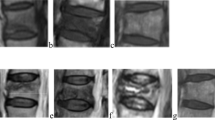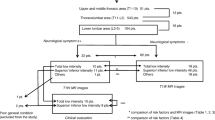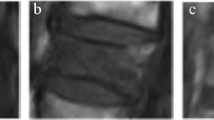Abstract
Purpose
The purpose of this study was to assess the ability of short inversion time inversion-recovery (STIR) in magnetic resonance imaging for predicting the prognosis of osteoporotic vertebral fractures.
Methods
We analyzed 63 vertebrae of 56 patients who had osteoporotic vertebral fracture (Th10–L2) prospectively. Image finding of a homogeneous high signal change on a fractured vertebra was evaluated and all vertebrae were divided into “homogenous high signal change group” or “non-homogenous high signal change group”. On the other hand, image finding of linear black signal area was evaluated and all vertebrae were divided into “linear black signal area group” or “non-linear black signal area group”.
Results
Sixteen and 24 vertebrae were included in the homogenous high signal change group or the linear black signal area group, respectively. The 16 homogenous high signal change cases did not result in non-union, and 47 non-homogenous high signal change cases resulted in 14 non-unions, a significant difference. Twenty-four linear black signal area and 39 non-linear black signal area cases resulted in 10, and 4 non-unions, respectively, also a significant difference. The kyphosis progression rate of the linear black signal area group (mean 35 %) was significantly higher than that of non-linear black signal area group (mean 23 %). The visual analog scale of back pain of the linear black signal area group (mean 35 mm) was significantly higher than that of the non-linear black signal area group (mean 23 mm).
Conclusions
STIR was useful for predicting bone union, kyphosis, and back pain in patients with osteoporotic vertebral fracture.





Similar content being viewed by others
References
Kanchiku T, Taguchi T, Kawai S (2003) Magnetic resonance imaging diagnosis and new classification of the osteoporotic vertebral fracture. J Orthop Sci 8:463–466
Kado DM, Lui LY, Ensrud KE, Fink HA, Karlamangla AS, Cummings SR (2009) Hyperkyphosis predicts mortality independent of vertebral osteoporosis in older women. Ann Intern Med 150:681–687
Baba H, Maezawa Y, Kamitani K, Furusawa N, Imura S, Tomita K (1995) Osteoporotic vertebral collapse with late neurological complications. Paraplegia 33:281–289
Bliuc D, Nguyen ND, Milch VE, Nguyen TV, Eisman JA, Center JR (2009) Mortality risk associated with low-trauma osteoporotic fracture and subsequent fracture in men and women. JAMA 301:513–521
Ito Z, Harada A, Matsui Y, Takemura M, Wakao N, Suzuki T, Nihashi T, Kawatsu S, Shimokata H, Ishiguro N (2006) Can you diagnose for vertebral fracture correctly by plain X-ray? Osteoporos Int 17:1584–1591
Spiegl UJ, Beisse R, Hauck S, Grillhosl A, Buhren V (2009) Value of MRI imaging prior to a kyphoplasty for osteoporotic insufficiency fractures. Eur Spine J 18:1287–1292
Harada A, Matsuyama Y, Nakano T, Deguchi M, Kuratsu S, Sueyoshi Y, Yonezawa Y, Wakao N, Machida M, Ito M (2010) Nationwide survey of current medical practices for hospitalized elderly with spine fractures in Japan. J Orthop Sci 15:79–85
Tsujio T, Nakamura H, Terai H, Hoshino M, Namikawa T, Matsumura A, Kato M, Suzuki A, Takayama K, Fukushima W, Kondo K, Hirota Y, Takaoka K (2011) Characteristic radiographic or magnetic resonance images of fresh osteoporotic vertebral fractures predicting potential risk for nonunion: a prospective multicenter study. Spine 36:1229–1235
Kanchiku T, Taguchi T, Toyoda K, Fujii K, Kawai S (2003) Dynamic contrast-enhanced magnetic resonance imaging of osteoporotic vertebral fracture. Spine 28:2522–2526 (discussion 2522)
Lin WC, Chen HL, Lu CH, Wang HC, Wu RW, Cheng YF, Lui CC (2011) Dynamic contrast-enhanced magnetic resonance imaging for evaluating intraosseous cleft formation in patients with osteoporotic vertebral compression fractures before vertebroplasty. Spine 36:1244–1250
Hashidate H, Kamimura M, Nakagawa H, Takahara K, Uchiyama S (2006) Pseudoarthrosis of vertebral fracture: radiographic and characteristic clinical features and natural history. J Orthop Sci 11:28–33
Niimi R, Kono T, Nishihara A, Hasegawa M, Matsumine A, Sudo A (2014) Efficacy of the dynamic radiographs for diagnosing acute osteoporotic vertebral fractures. Osteoporos Int 25:605–612
Hasegawa K, Homma T, Uchiyama S, Takahashi H (1998) Vertebral pseudarthrosis in the osteoporotic spine. Spine 23:2201–2206
Kanchiku T, Imajo Y, Suzuki H, Yoshida Y, Taguchi T (2014) Usefulness of an early MRI-based classification system for predicting vertebral collapse and pseudoarthrosis after osteoporotic vertebral fractures. J Spinal Disord Tech 27:E61–E65
Wardlaw D, Cummings SR, Van Meirhaeghe J, Bastian L, Tillman JB, Ranstam J, Eastell R, Shabe P, Talmadge K, Boonen S (2009) Efficacy and safety of balloon kyphoplasty compared with non-surgical care for vertebral compression fracture (FREE): a randomised controlled trial. Lancet 373:1016–1024
Kallmes DF, Ba Comstock, Heagerty PJ, Turner JA, Wilson DJ, Diamond TH, Edwards R, Gray LA, Stout L, Owen S, Hollingworth W, Ghdoke B, Annesley-Williams DJ, Ralston SH, Jarvik JG (2009) A randomized trial of vertebroplasty for osteoporotic spinal fractures. N Engl J Med 361:569–579
Buchbinder R, Osborne RH, Ebeling PR, Wark JD, Mitchell P, Wriedt C, Graves S, Staples MP, Murphy B (2009) A randomized trial of vertebroplasty for painful osteoporotic vertebral fractures. N Engl J Med 361:557–568
Edidin AA, Ong KL, Lau E, Kurtz SM (2011) Mortality risk for operated and nonoperated vertebral fracture patients in the medicare population. J Bone Miner Res 26:1617–1626
Linn J, Birkenmaier C, Hoffmann RT, Reiser M, Baur-Melnyk A (2009) The intravertebral cleft in acute osteoporotic fractures: fluid in magnetic resonance imaging-vacuum in computed tomography? Spine (Phila Pa 1976) 34:E88–E93
Theodorou DJ (2001) The intravertebral vacuum cleft sign. Radiology 221:787–788
Mirovsky Y, Anekstein Y, Shalmon E, Peer A (2005) Vacuum clefts of the vertebral bodies. Am J Neuroradiol 26:1634–1640
Yu CW, Hsu CY, Shih TT, Chen BB, Fu CJ (2007) Vertebral osteonecrosis: MR imaging findings and related changes on adjacent levels. Am J Neuroradiol 28:42–47
Conflict of interest
None.
Author information
Authors and Affiliations
Corresponding author
Rights and permissions
About this article
Cite this article
Omi, H., Yokoyama, T., Ono, A. et al. Can MRI predict subsequent pseudarthrosis resulting from osteoporotic thoracolumbar vertebral fractures?. Eur Spine J 23, 2705–2710 (2014). https://doi.org/10.1007/s00586-014-3490-9
Received:
Revised:
Accepted:
Published:
Issue Date:
DOI: https://doi.org/10.1007/s00586-014-3490-9




